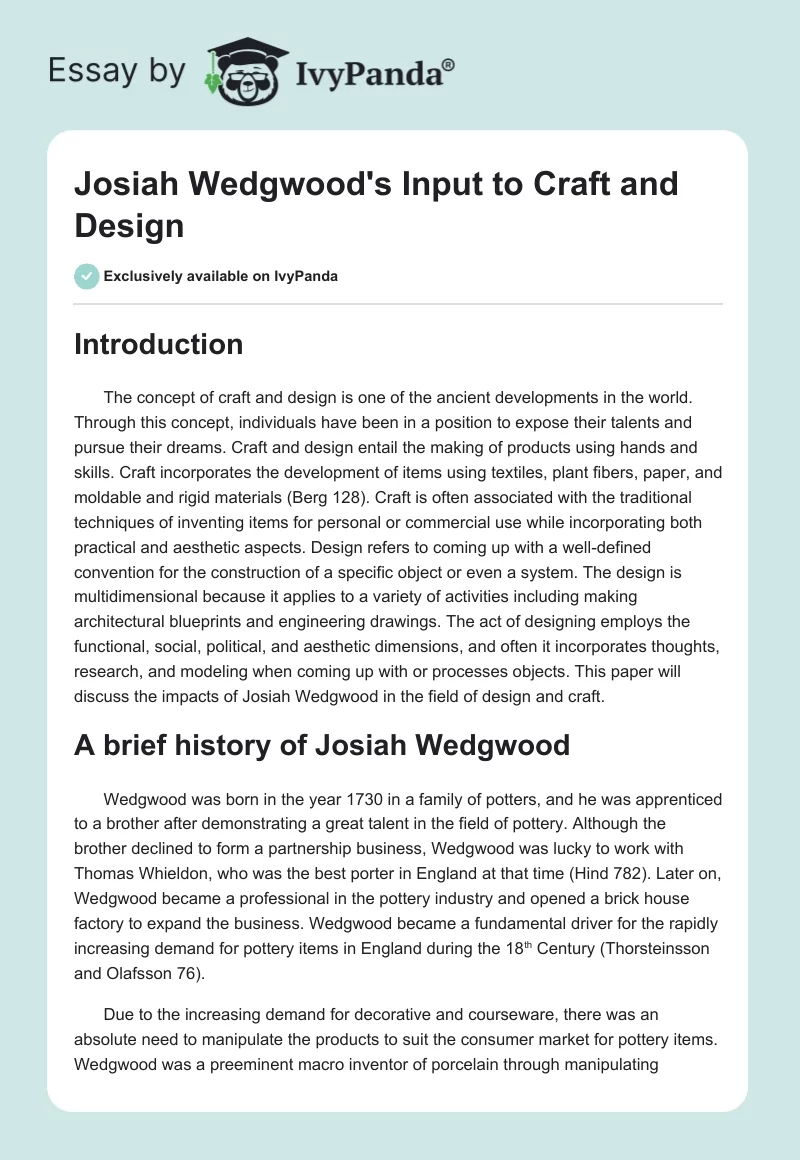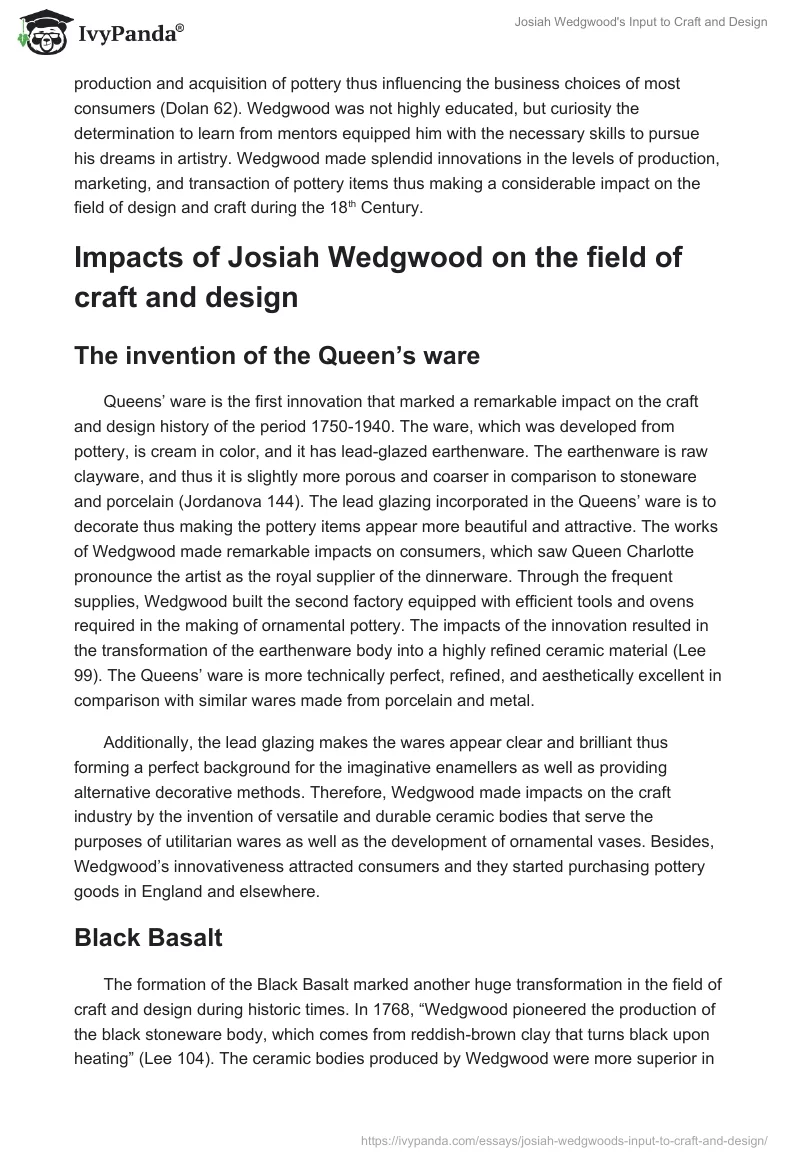Introduction
The concept of craft and design is one of the ancient developments in the world. Through this concept, individuals have been in a position to expose their talents and pursue their dreams. Craft and design entail the making of products using hands and skills. Craft incorporates the development of items using textiles, plant fibers, paper, and moldable and rigid materials (Berg 128). Craft is often associated with the traditional techniques of inventing items for personal or commercial use while incorporating both practical and aesthetic aspects. Design refers to coming up with a well-defined convention for the construction of a specific object or even a system. The design is multidimensional because it applies to a variety of activities including making architectural blueprints and engineering drawings. The act of designing employs the functional, social, political, and aesthetic dimensions, and often it incorporates thoughts, research, and modeling when coming up with or processes objects. This paper will discuss the impacts of Josiah Wedgwood in the field of design and craft.
A brief history of Josiah Wedgwood
Wedgwood was born in the year 1730 in a family of potters, and he was apprenticed to a brother after demonstrating a great talent in the field of pottery. Although the brother declined to form a partnership business, Wedgwood was lucky to work with Thomas Whieldon, who was the best porter in England at that time (Hind 782). Later on, Wedgwood became a professional in the pottery industry and opened a brick house factory to expand the business. Wedgwood became a fundamental driver for the rapidly increasing demand for pottery items in England during the 18th Century (Thorsteinsson and Olafsson 76).
Due to the increasing demand for decorative and courseware, there was an absolute need to manipulate the products to suit the consumer market for pottery items. Wedgwood was a preeminent macro inventor of porcelain through manipulating production and acquisition of pottery thus influencing the business choices of most consumers (Dolan 62). Wedgwood was not highly educated, but curiosity the determination to learn from mentors equipped him with the necessary skills to pursue his dreams in artistry. Wedgwood made splendid innovations in the levels of production, marketing, and transaction of pottery items thus making a considerable impact on the field of design and craft during the 18th Century.
Impacts of Josiah Wedgwood on the field of craft and design
The invention of the Queen’s ware
Queens’ ware is the first innovation that marked a remarkable impact on the craft and design history of the period 1750-1940. The ware, which was developed from pottery, is cream in color, and it has lead-glazed earthenware. The earthenware is raw clayware, and thus it is slightly more porous and coarser in comparison to stoneware and porcelain (Jordanova 144). The lead glazing incorporated in the Queens’ ware is to decorate thus making the pottery items appear more beautiful and attractive. The works of Wedgwood made remarkable impacts on consumers, which saw Queen Charlotte pronounce the artist as the royal supplier of the dinnerware. Through the frequent supplies, Wedgwood built the second factory equipped with efficient tools and ovens required in the making of ornamental pottery. The impacts of the innovation resulted in the transformation of the earthenware body into a highly refined ceramic material (Lee 99). The Queens’ ware is more technically perfect, refined, and aesthetically excellent in comparison with similar wares made from porcelain and metal.
Additionally, the lead glazing makes the wares appear clear and brilliant thus forming a perfect background for the imaginative enamellers as well as providing alternative decorative methods. Therefore, Wedgwood made impacts on the craft industry by the invention of versatile and durable ceramic bodies that serve the purposes of utilitarian wares as well as the development of ornamental vases. Besides, Wedgwood’s innovativeness attracted consumers and they started purchasing pottery goods in England and elsewhere.
Black Basalt
The formation of the Black Basalt marked another huge transformation in the field of craft and design during historic times. In 1768, “Wedgwood pioneered the production of the black stoneware body, which comes from reddish-brown clay that turns black upon heating” (Lee 104). The ceramic bodies produced by Wedgwood were more superior in their appearance in comparison to the local Egyptian black wares, which were common during that period. The Black Basalt body is “richer in color due to the addition of manganese thus resulting in the production of excellent ornamental wares such as portrait medallions, vases, plaques candlesticks, and library busts” (Walton 102).
The Etruscan vases caught the attention of Wedgwood, and thus he copied and applied the materials, techniques, and shapes of the same in his works. New forms of decoration that incorporated “bronzing and encaustic painting to resemble the Greek and Italian vases require smooth services thus making the Black Basalt an ideal body when developing such vases” (Wedgwood and Farrer 72). Additionally, through the development of the Black Basalt, “encaustic designs are easily painted in the smooth service using a brush to allow a variety of colors such as blue, green, pink, and orange among others to be incorporated” (Wedgwood and Farrer 72). This aspect creates a distinction with the ancient vases that are either black or red.
The introduction of the Black Basalt heralded a period of unparalleled economic growth and success in the industry. Different creations have been made from this innovation to suit different consumer preferences. Due to the smooth and lustrous surface of the antique ware as well as the purple-black sheen, the Black Basalt stands out in the world of art (Miller 85). The impacts of ancient developments by Wedgwood products are felt today because varieties of ornamental pieces that incorporate exquisite ceramic bodies are in high demand.
The Jasperware
Jasperware was introduced after a series of experiments that were conducted to establish the techniques of porcelain manufacture. The ware resembles the hardness of Jasper natural stone thus hinting the origin of the term Jasperware. The invention acted as a landmark since the discovery of the porcelain. Jasper is “white in its natural state, but it is stained using metallic oxides that act as coloring agents and the most shared shades of Jasperware are pale blue although lilac, sage, green, dark blue and yellow” (Shiner 233). The decorations in the neoclassical style and especially white are made in distinct patterns and later applied to the body of the piece (Shiner 234). Jasperware is made in different ways. Some of the pieces are made from solid-colored clay that is combined with outstretched designs of contrasting colored clay while other pieces are just developed from a single clay color with raised decorations that are glazed by using a contrasting color.
The ability of Wedgwood to develop “new ceramic material to resemble the admixture of uniform color resulted in a wide range of combinations that marked the successful development of decorative wares” (Wedgwood and Farrer 45).
The innovation of the pyrometer
The design incorporates the construction of new items as well as defining the plan to be followed when coming up with new products or processes. Wedgwood invented the pyrometer, which is essential in the determination of oven temperatures. The pyrometer was designed in the 18th Century to determine measurements based on the sintering of clay when heated above the red heat. The innovation had various positive impacts in the field of art and craft because the inventors using clay as a raw material for the production of products would easily compare the shrinking of clay due to different temperatures (Miller 132).
Conclusion
The field of craft and design has attracted attention among various artists, architects, and craft persons around the globe who made significant transformation during the era of revolution. Some of the common professionals in this field include Josiah Wedgwood, William Morris, Augustus Pugin, John Ruskin, Adolf Loos, and more others. Craft entails making functional objects skillfully by the use of hands. Craft is affiliated to art because some of the objects aimed at achieving aesthetic value, but not direct usage. The design incorporates architecture, graphics, product, and interior design. Josiah Wedgwood made remarkable impacts on the development of craft and design during the period 1730-1945. Some of the achievements include the innovation of the Queen’s ware, the jasperware, the invention of the Black Basalt, and the pyrometer. The inventions of Wedgwood transformed the pottery industry significantly.
Works Cited
Berg, Maxine. “Skill, Craft, and Histories of Industrialization in Europe and Asia.” Transactions of the Royal Historical Society 24.1 (2014): 127-148. Print.
Dolan, Brian. Wedgwood: The First Tycoon, New York: Viking Press, 2004. Print.
Hind, Ray. “Josiah Wedgwood and his influence on the English Pottery Industry.” Nature 125.3160 (1930): 781-783. Print.
Jordanova, Ludmilla. The look of the past: visual and material evidence in historical Practice, Cambridge University Press, 2012. Print.
Lee, Yunah. “Design Histories and Design Studies in East Asia: Part 3 Korea and Conclusion.” Journal of Design History 25.1 (2012): 93-106. Print.
Miller, George. “Origins of Josiah Wedgwood’s ‘Pearlware’.” Northeast Historical Archaeology 16.1 (1987): 83-95. Print.
Shiner, Larry. ““Blurred Boundaries”? Rethinking the Concept of Craft and its Relation to Art and Design.” Philosophy Compass 7.4 (2012): 230-244. Print.
Thorsteinsson, Gisli, and Brynjar Olafsson. “Revisiting sloyd: curriculum development of design and craft in Iceland: sloyd pedagogy as the basis for design and craft education in Iceland.” Technologies and Vocational Education Research 10.1 (2013): 74-81. Print.
Walton, Inga. “Wedgwood in Melbourne.” Ceramics Technical 37.1 (2013): 102-4. Print.
Wedgwood, Josiah, and Katherine Farrer. Correspondence of Josiah Wedgwood, Cambridge: Cambridge University Press, 2011. Print.


